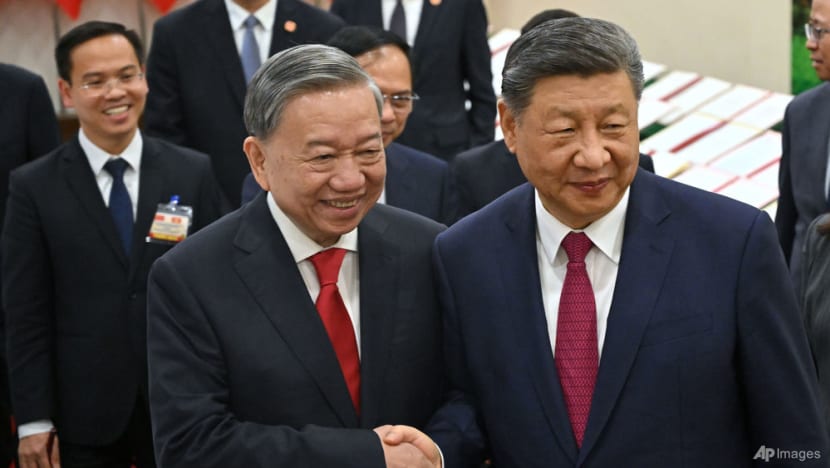Commentary: Xi Jinping’s visit to Vietnam is not all about Donald Trump
Hanoi’s welcome of the Chinese president amid the global tariff war is about serving Vietnam’s national interests and development, says this ISEAS-Yusof Ishak Institute researcher.

SINGAPORE: Chinese President Xi Jinping’s visit to Vietnam from Apr 14 to Apr 15 came just days after US President Donald Trump’s “Liberation Day” announcement of sweeping global tariffs, amid Washington’s looming 46 per cent tariff on Vietnamese goods and escalating China-US geoeconomic confrontation. Caught squarely in the crossfire, Vietnam faces mounting pressure from both sides: Xi has cautioned Hanoi against appeasing Washington, while Trump swiftly framed Xi’s visit as an attempt to “screw” the US.
Yet, for all the shadows cast by Trump’s tariffs, the true significance of Xi’s visit lies in the deeper political and economic currents that can potentially reshape the future of Vietnam-China relations.
For China, Xi’s trip to Vietnam – as part of a bigger Southeast Asia tour – came on the heels of its Central Conference on Work Relating to Neighbouring Countries that took place between Apr 8 and Apr 9. The conference underscored the strategic imperative of China’s neighbourhood diplomacy as it enters “a critical phase of deep linkage between regional landscape and… world changes”, hence China’s need to “view neighbouring regions through a global perspective”.
China’s renewed emphasis on its periphery as a buffer against Western confrontation and isolation is a time-tested strategy.
After the 1989 Tiananmen incident and the collapse of the Communist bloc, Beijing turned to ASEAN to stabilise its external environment, while Vietnam seized the moment to normalise ties with China and resolve the Kampuchea issue. This resulted in a diplomatic breakthrough that ended over a decade of hostility between the two countries.
STRATEGIC NECESSITY, NOT MERE COUNTERWEIGHT
For Vietnam, China’s strategic focus on its neighbourhood could present another important opening for national development.
As the country ushers in a “new era” under the Vietnamese Communist Party’s (VCP) new leader, To Lam, strategic stability in its external environment is paramount. With internal political transitions underway and the 14th National Party Congress on the horizon, the Vietnamese leadership understands that the success of their ambitious reform agenda rests on shielding the domestic landscape from external volatility.
The disruptive forces that Trump has unleashed in the international system only incentivise Vietnam to cultivate a constructive and stable relationship with China: not as a counterweight to Washington, but as a strategic necessity to safeguard Vietnam’s security and development.
Of note, Hanoi’s ongoing efforts to recalibrate its development model calls for a pragmatic and productive relationship with China.
While reversing Trump’s tariffs is an immediate imperative, the situation also exposes the structural limits of Vietnam’s long-standing growth formula – an export-driven economy based on cheap labour, low-cost land, and little local value-add, whether in textiles, electronics or mobile phones.
Under To Lam’s leadership, Hanoi is setting its sights on a more resilient path, built on not only foreign direct investment and export but also new local growth drivers of infrastructural investment, innovation, and technology.
This strategic pivot is taking shape in policy terms. The VCP Central Committee’s Resolution 57-NQ/TW (December 2024) places breakthrough development in science, technology, innovation and digital transformation at the heart of Vietnam’s economic transition, identifying people and enterprises as the principal agents of change.
Resolution 59 (January 2025) reaffirms Vietnam’s commitment to proactive and comprehensive international integration despite global headwinds. Concurrently, the sweeping streamlining of the bureaucratic apparatus to address institutional bottlenecks underscores Hanoi’s determination to remove internal barriers to development.

VIETNAM’S SUBTLE SHIFT
Xi’s visit offered Vietnam an opportunity to secure Chinese backing for its ambitious development agenda. Foremost among Hanoi’s priorities is advancing investment-led growth over the coming decade, necessitating enhanced infrastructure cooperation with China.
While Vietnam has traditionally approached China’s Belt and Road Initiative with caution, recent developments suggest a subtle shift.
This is reflected in multiple cooperation agreements signed during Xi’s visit, covering road transport, energy infrastructure, seaports, logistics, aviation, and notably, the establishment of a joint committee on railway cooperation.
The committee’s priority is the construction of cross-border railways linking China to key cities in northern Vietnam, with Chinese technical assistance and concessional loans. This time around, Hanoi has strongly emphasised China’s technology transfer and capacity building, aiming to enhance domestic firms’ participation in its upcoming flagship project: the North-South high-speed railway.
Another key priority for Hanoi is increasing Vietnamese firms’ integration into high-value supply chains in sectors where China already commands technological and industrial leadership, such as high-speed railways, artificial intelligence, and green technologies.
Like China, Vietnam is nurturing its national economic champions, including Viettel and FPT in tech sectors, VinFast in EVs and Hoa Phat in steelmaking. Vietnamese leaders are intent on steering these firms beyond being mere technology adopters to become technology innovators capable of capturing greater value shares, particularly in Vietnam’s rapidly expanding market.
Economic cooperation with China offers a practical, albeit complex, pathway towards fulfilling this ambition. Granted, challenges persist: from the risk of Vietnam’s market being flooded with Chinese products amid their now constrained access to the US market and Washington’s intense scrutiny on Vietnam-China economic entanglement to Chinese restrictions on technology transfer and Beijing’s caution against Chinese firms shifting supply chains overseas.
A LEVEL OF POLITICAL TRUST
Yet, Vietnam’s growing openness to deeper Chinese involvement in its infrastructure and technological ecosystems – as shown during Xi’s visit – reflects a level of political courage and trust among the current Vietnamese leadership towards China, which is unseen in recent times.
The strategic logic behind Xi’s visit – and Hanoi’s welcome – was set in motion long before Trump’s shocking tariffs made headlines. The trip’s significance lies not in Hanoi’s allegiance to any camp but was a litmus test of Hanoi’s ability to balance great power relations while keeping national development at the heart of its foreign policy.
The real question is not which way the Vietnamese bamboo bends but how deeply its roots are anchored and how carefully its strategy aligns external partnerships with domestic priorities. The compass guiding Vietnam remains steady: stability, development, internal resilience and an openness to engage all partners on terms that serve its national interest.
Hoang Thi Ha is Senior Fellow and Co-coordinator of the Regional Strategic and Political Studies Programme, ISEAS – Yusof Ishak Institute. This commentary first appeared on ISEAS – Yusof Ishak Institute's blog, Fulcrum.




















